| Episode 203 Costa Rica: Rincon De La Vieja -- Leatherback Turtle | ||
| This week I traveled to a place where a 4x4 vehicle is a must: Rincon de la Vieja in Costa Rica. The Costa Rican tropical rain forest is beautiful, filled with animals and plants -- but it can mighty hard to get around! | ||
| Costa Rica is home to over 800 species of birds, some of them pretty incredible -- like the toucan I spotted from my 4x4. This bird uses its oversized bill like tweezers to grab at prey. And the toucan is an omnivore -- it eats seeds, fruit, lizards, and other birds. | 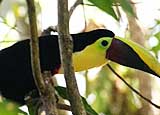 |
|
| I started this adventure in the northwest portion of Costa Rica, just below the rim of an ancient volcano. To begin our search for our feature creature, the leatherback turtle, I had to travel one mile straight down the Rincon de la Vieja (the "slope of the old woman"), as it's called here. | ||
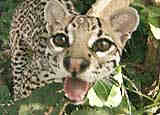 |
On the way down I saw an ocelot. "Ocelot" is the Aztec word for "field cat." The ocelot is usually an active hunter at night, but it will also hunt during the day. The ocelot is endangered because its beautiful pelt is prized for coats. I think its pelt looks best just where it is! | |
| I saw a plume of what looked like smoke down the hill -- but it was hovering and not going straight up, which told me that it was steam. I climbed down to it and saw a bubbling hot pool of water, superheated by the volcanic heat buried in this ancient mountain. | 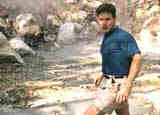 |
|
|
This water is so hot I'd be poached dead in a minute if I walked into it! Not all the interesting living things in Costa Rica are animals. I crouched by a mimosa plant that has an interesting defense. The mimosa can actually close its small leaflets when touched by a hungry creature, exposing a sharp thorn. Everyone has heard of vampire bats, and they are real! They bite into the flesh of an animal, usually a cow, and then suck at the blood. They have a special saliva that makes the blood flow and also prevents the bitten creature from feeling pain |
||
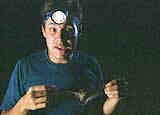 |
I set up a mist net to capture a vampire bat, but instead I snared a dog-faced bat. Not a bloodsucker, this bat makes high-frequency sounds to locate insects like the beetles it eats. | |
| Looking up, I saw a white-faced capuchin monkey. These are some of the smartest monkeys in the world. People think they make good pets, but because they are so smart, they get very tired of captivity when fully grown. Like the toucan, these monkeys are omnivores. |  |
|
| I was lucky to be in Costa Rica that day since there was an 80% eclipse of the sun. During a solar eclipse, the moon blocks the sun. I used special glasses to see an incredible sight -- the sun with a big "bite" out of it! | ||
 |
Costa Rica is home to hundreds of species of butterflies. None is more beautiful than the morpho - so it's a real pleasure to find one. The morpho has stunning sky-blue wings. | |
| I also found an owl butterfly, named for the big owl-eyes on its wings --designed to startle or scare any would-be predators. Those phony eyes are a great fake-out. | 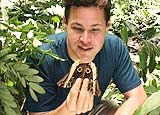 |
|
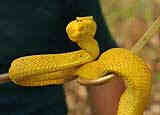 |
Near the butterfly I find an animal that is seriously dangerous, the eyelash viper. This poisonous snake is adapted to live in treetops. It has strong muscles to hold onto limbs, and a prehensile tail. The eyelash viper can be found throughout the tropics. | |
| Nearby I spotted another tree dweller, the tyra, also called the bush dog. The tyra looks like a dog, but it's not canine at all. It's more closely related to weasels and otters. | 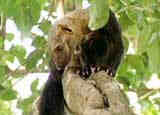 |
|
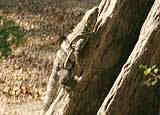 |
When I caught a spiky-tailed iguana, I knew we were close to where we'd find our feature creature. This animal lives near the beach and has a great defense: If a predator grabs its tail, the iguana can let it "pop" off, and escape. It then grows a new tail. | |
| Finally I reached the beach, and, setting my alarm for midnight, I slept a bit before waking to catch an incredible sight: the leatherback laying its eggs. This great sea turtle comes back to the beach where it was born and uses its rear flippers to dig a hole to lay its eggs. Then the leatherback leaves, never to return. | ||
| And what happens then? After a gestation period, the eggs hatch, and the tiny leatherback babies struggle to the top of the beach. Then they have to make it to the water. | 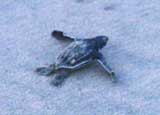 |
|
|
Very few of the babies survive the race to the water, and even in the water they face danger from other predators. But the ones who do survive will return as adults to lay their eggs at this very same beach! It's hard to leave beautiful Costa Rica, but there's more adventure and wild animals ahead! See you next week!
|
||
| Totally wild, Jeff |
||